Layered Cuprates Containing Flat Fragments: High-Pressure Synthesis, Crystal Structures and Superconducting Properties †
Abstract
1. Introduction
2. Au-Containing Cuprates: High-Pressure Synthesis and Characterization
3. Au and Hg-Containing Series: Structural Details and Superconductivity
4. La2CuO4 -Related Superconductors in Sr-Cu-O and Ba-Cu-O Systems
5. Cuprates with Edge-Shared CuO4 Units in Sr-Cu-O and Ca-Cu-O Systems: Spin-Ladder and Infinite-Chain Composite Structures
- (1)
- monoclinic subcell with a = 3.33 Å, b = 6.32 Å, c = 5.47 Å, ß = 105.0°
- (2)
- monoclinic subcell with a = 2.80 Å, b = 6.32 Å, c = 5.47 Å, ß = 104.9°
6. Importance of High-Pressure for Synthesis of New Oxide Superconductors and Future Prospects
7. Conclusions
Funding
Acknowledgments
Conflicts of Interest
References
- Abakumov, A.M.; Antipov, E.V.; Kovba, L.M.; Kopnin, E.M.; Putilin, S.N.; Shpanchenko, R.V. Complex oxides with coherent intergrowth structures. Russ. Chem. Rev. 1995, 64, 719–729. [Google Scholar] [CrossRef]
- Bednorz, J.G.; Müller, K.A. Possible high Tc superconductivity in the Ba-La-Cu-O system. Z. Phys. B 1986, 64, 189. [Google Scholar] [CrossRef]
- Chu, C.W.; Hor, P.H.; Meng, R.L.; Gao, L.; Huang, Z.J. Superconductivity at 52.5 K in the Lanthanum-Barium-Copper-Oxide System. Science 1987, 235, 567–569. [Google Scholar] [CrossRef]
- Putilin, S.N.; Antipov, E.V.; Chmaissem, O.; Marezio, M. Superconductivity at 94 K in HgBa2Cu04+δ. Nature 1993, 362, 226. [Google Scholar] [CrossRef]
- Schilling, A.; Cantoni, M.; Guo, J.D.; Ott, H.R. Superconductivity above 130 K in the Hg–Ba–Ca–Cu–O system. Nature 1993, 363, 58. [Google Scholar] [CrossRef]
- Antipov, E.; Loureiro, S.; Chaillout, C.; Capponi, J.; Bordet, P.; Tholence, J.; Putilin, S.; Marezio, M. The synthesis and characterization of the HgBa2Ca2Cu3O8+δ and HgBa2Ca3Cu4O10+δ phases. Phys. C Supercond. 1993, 215, 1–10. [Google Scholar] [CrossRef]
- Capponi, J.; Kopnin, E.; Loureiro, S.; Antipov, E.; Gautier, E.; Chaillout, C.; Souletie, B.; Brunner, M.; Tholence, J.; Marezio, M. High-pressure synthesis and heat treatments of the HgBa2Ca4Cu5O12+δ and HgBa2Ca5Cu6O14+δ phases. Phys. C Supercond. 1996, 256, 1–7. [Google Scholar] [CrossRef]
- Karpinski, J.; Schwer, H.; Conder, K.; Meijer, G.I.; Kopnin, E.; Molinski, R. High pressure crystal growth of Y2Ba4Cu6+nO14+n and HgBa2Can-1CunO2n+2+δ superconductors. Solid State Ionics 1997, 101–103, 985. [Google Scholar] [CrossRef]
- Schwer, H.; Molinski, R.; Kopnin, E.; Meijer, G.I.; Karpinski, J. Structure and Properties of 1256 and 1267 Type Hg1-xRexBa2Can-1CunO2n+2+4x+d single crystals. J. Solid State Chem. 1999, 43, 277. [Google Scholar] [CrossRef]
- Núñez-Regueiro, M.; Tholence, J.-L.; Antipov, E.V.; Capponi, J.-J.; Marezio, M.; Anderson, P.W. Pressure-Induced Enhancement of Tc Above 150 K in Hg-1223. Science 1993, 262, 97–99. [Google Scholar] [CrossRef]
- Monteverde, M.; Acha, C.; Nuňez-Regueiro, M.; Pavlov, D.A.; Lokshin, K.A.; Putilin, S.N.; Antipov, E.V. High-pressure effects in fluorinated HgBa2Ca2Cu3O8+δ. Europhys. Lett. 2005, 72, 458. [Google Scholar] [CrossRef][Green Version]
- Yamamoto, A.; Takeshita, N.; Terakura, C.; Tokura, Y. High-pressure effects revisited for the cuprate superconductor family with highest critical temperature. Nat. Commons 2015, 6, 8990. [Google Scholar] [CrossRef]
- Liu, X.Y. High pressure synthesis and preparation of inorganic materials. In Modern Inorganic Synthetic Chemistry, 2nd ed.; Elsevier: Amsterdam, The Netherlands, 2017; Chapter 5; pp. 105–141. [Google Scholar]
- Drozdov, A.P.; Eremets, M.I.; Troyan, I.A.; Ksenofontov, V.; I Shylin, S. Conventional superconductivity at 203 kelvin at high pressures in the sulfur hydride system. Nat. Cell Biol. 2015, 525, 73–76. [Google Scholar] [CrossRef]
- Drozdov, A.P.; Kong, P.P.; Minkov, V.S.; Besedin, S.P.; Kuzovnikov, M.A.; Mozaffari, S.; Balicas, L.; Balakirev, F.F.; Graf, D.E.; Prakapenka, V.B.; et al. Superconductivity at 250 K in lanthanum hydride under high pressures. Nat. Cell Biol. 2019, 569, 528–531. [Google Scholar] [CrossRef]
- Pietronero, L.; Strässler, S.; Grimaldi, C. Nonadiabatic superconductivity. I. Vertex corrections for the electron-phonon in-teractions. Phys. Rev. B 1995, 52, 10516. [Google Scholar] [CrossRef] [PubMed]
- Grimaldi, C.; Pietronero, L.; Strässler, S. Nonadiabatic superconductivity. II. Generalized Eliashberg equations beyond Migdal’s theorem. Phys. Rev. B 1995, 52, 10530. [Google Scholar] [CrossRef] [PubMed]
- Wang, H.; Tse, J.S.; Tanaka, K.; Iitaka, T.; Ma, Y. Superconductive sodalite-like clathrate calcium hydride at high pressures. Proc. Natl. Acad. Sci. USA 2012, 109, 6463–6466. [Google Scholar] [CrossRef]
- Szczȩśniak, D.; Zemła, T.P.; Szczęśniak, D. On the high-pressure superconducting phase in platinum hydride. Supercond. Sci. Technol. 2015, 28, 85018. [Google Scholar] [CrossRef]
- Peng, F.; Sun, Y.; Pickard, C.J.; Needs, R.J.; Wu, Q.; Ma, Y. Hydrogen Clathrate Structures in Rare Earth Hydrides at High Pressures: Possible Route to Room-Temperature Superconductivity. Phys. Rev. Lett. 2017, 119, 107001. [Google Scholar] [CrossRef] [PubMed]
- Liu, H.; Naumov, I.I.; Geballe, Z.M.; Somayazulu, M.; Tse, J.S.; Hemley, R.J. Dynamics and superconductivity in compressed lanthanum superhydride. Phys. Rev. B 2018, 98, 100102. [Google Scholar] [CrossRef]
- Szczȩśniak, D.; Szczȩśniak, R. Signatures of nonadiabatic superconductivity in lithium-decorated graphene. Phys. Rev. B 2019, 99, 224512. [Google Scholar] [CrossRef]
- Schrodi, F.; Oppeneer, P.M.; Aperis, A. Full-bandwidth Eliashberg theory of superconductivity beyond Migdal’s approximation. Phys. Rev.B 2020, 102, 024503. [Google Scholar] [CrossRef]
- Bordet, P.; Lefloch, S.; Chaillout, C.; Duc, F.; Gorius, M.; Perroux, M.; Capponi, J.; Toulemonde, P.; Tholence, J. AuBa2(Y1−x, Cax)Cu2O7: A new superconducting gold cuprate with Tc above 80 K. Phys. C Supercond. 1997, 276, 237–244. [Google Scholar] [CrossRef]
- Bordet, P.; Kopnin, E.M.; Sato, A.; Takayama-Muromachi, E. Structure analysis of superconducting Au-1212 cuprate. Supercond. Sci. Technol. 2003, 16, 685–689. [Google Scholar] [CrossRef]
- Kopnin, E.M.; Loureiro, S.M.; Asaka, T.; Anan, Y.; Matsui, Y.; Takayama-Muromachi, E. New family of Au-based supercon-ductors AuBa2Can-1CunO2n+3 (n = 3, 4). Chem. Mater. 2001, 13, 2905. [Google Scholar] [CrossRef]
- Kopnin, E.; Sato, A.; Asaka, T.; Matsui, Y.; Takayama-Muromachi, E. Structure analysis of Au-containing cuprate of Au1+xBa2Ca2Cu3−xO9 (Au-1223). Phys. C Supercond. 2003, 387, 406–410. [Google Scholar] [CrossRef]
- Kopnin, E.; Sato, A.; Asaka, T.; Matsui, Y.; Takayama-Muromachi, E. High-pressure synthesis and characterization of the Au-1201 phase. J. Alloy. Compd. 2003, 361, 28–31. [Google Scholar] [CrossRef]
- Lokshin, K.; Kuzemskaya, I.; Kulikova, L.; Antipov, E.; Itskevich, E. High pressure synthesis of Hg-1234 and strongly-overdoped Hg-1223 phases. Phys. C Supercond. 1997, 279, 11–17. [Google Scholar] [CrossRef]
- Zhao, J.; Dong, C.; Fan, Y.; Wu, F.; Chen, H.; Che, G.; Zhao, Z. Determination of the solid-solution region of infinite-layer compound (SrxCa1−x)CuO2 under ambient pressure by X-ray diffraction. Phys. C Supercond. 1996, 264, 19–21. [Google Scholar] [CrossRef]
- Takano, M.; Takeda, Y.; Okada, H.; Miyamoto, M.; Kusaka, T. ACuO2 (A: Alkaline earth) crystallizing in a layered structure. Phys. C Supercond. 1989, 159, 375–378. [Google Scholar] [CrossRef]
- Kopnin, E.; Schwer, H.; Jun, J.; Meijer, G.; Molinski, R.; Conder, K.; Karpinski, J. Ca1−xRxCuO2 (R = Sr, La) single crystals with infinite-layer structure: High Ar gas pressure synthesis and properties. Phys. C Supercond. 1997, 282-287, 483–484. [Google Scholar] [CrossRef]
- Crespin, M.; Isnard, O.; Dubois, F.; Choisnet, J.; Odier, P. LaNiO2: Synthesis and structural characterization. J. Solid State Chem. 2005, 178, 1326–1334. [Google Scholar] [CrossRef]
- Wang, B.X.; Zheng, H.; Krivyakina, E.; Chmaissem, O.; Lopes, P.P.; Lynn, J.W.; Leighanne, C.G.; Ren, Y.; Rosenkranz, S.; Mitchell, J.F.; et al. Synthesis and characterization of bulk Nd1-xSrxNiO3 and Nd1-xSrxNiO2. Phys. Rev. Mater. 2020, 4, 8. [Google Scholar] [CrossRef]
- Teske, C.L.; Müller-Buschbaum, H.K. Oxocuprate. II. Zur Kenntnis von Sr2CuO3. Z. Anorg. Allg. Chem. 1969, 371, 325. (In German) [Google Scholar] [CrossRef]
- Hiroi, Z.; Takano, M.; Azuma, M.; Takeda, Y. A new family of copper oxide superconductors Srn+1CunO2n+1+δ stabilized at high pressure. Nat. Cell Biol. 1993, 364, 315–317. [Google Scholar] [CrossRef]
- Han, P.D.; Chang, L.; Payne, D.A. High-pressure synthesis of the Sr2CuO3+δ superconductor. Observation of an increase in Tc from 70 K to 94 K with heat treatment. Physica C 1994, 228, 129. [Google Scholar] [CrossRef]
- Geballe, T.H. The Never-Ending Search for High-Temperature Superconductivity. J. Supercond. Nov. Magn. 2006, 19, 261–276. [Google Scholar] [CrossRef][Green Version]
- Shimakawa, Y.; Jorgensen, J.; Mitchell, J.; Hunter, B.; Shaked, H.; Hinks, D.; Hitterman, R.; Hiroi, Z.; Takano, M. Structural study of Sr2CuO3+δ by neutron powder diffraction. Phys. C Supercond. 1994, 228, 73–80. [Google Scholar] [CrossRef]
- Liu, Q.Q.; Yang, H.; Qin, X.M.; Yu, Y.; Yang, L.X.; Li, F.Y.; Yu, R.C.; Jin, C.Q.; Uchida, S. Enrichment of superconducting critical temperature of Sr2CuO3+δ up to 95 K by ordering dopant atoms. Phys. Rev. B 2006, 74, 100506 (R). [Google Scholar] [CrossRef]
- Yang, H.; Liu, Q.Q.; Li, F.Y.; Jin, C.Q.; Yu, R.C. TEM and EELS characterization of a Sr2CuO3+δ superconductor post-annealed at different temperatures: Enhancement of Tc by apical oxygen reordering. Supercond. Sci. Technol. 2007, 20, 904. [Google Scholar] [CrossRef]
- Scott, B.A.; Walker, D.; Kirtley, J.R.; Chen, B.-H.; Wang, Y. Materials analysis by scanning SQUID petrology: Application to high pressure superconducting phase in the Sr-Cu-O-Cl system. Nature 1997, 389, 164. [Google Scholar] [CrossRef]
- Gao, W.B.; Liu, Q.Q.; Yang, L.Q.; Yu, Y.; Li, F.Y.; Jin, C.Q.; Uchida, S. Out-of-plane effect on the superconductivity of Sr2−xBaxCuO3+δ with Tc up to 98 K. Phys. Rev. B 2009, 80, 094523. [Google Scholar] [CrossRef]
- Geballe, T.; Marezio, M. Enhanced superconductivity in Sr2CuO4−v. Phys. C Supercond. 2009, 469, 680–684. [Google Scholar] [CrossRef]
- Wang, Y.; Zhang, H.; Dravid, V.; Marks, L.; Han, P.; Payne, D. A TEM study of the incommensurate modulated structure in Sr2CuO3 + δ superconductor synthesized under high pressure A. Evolution of the incommensurate modulated structure and the electronic structure with post-heat treatment. Phys. C Supercond. 1995, 255, 247–256. [Google Scholar] [CrossRef]
- Zhang, H.; Wang, Y.; Marks, L.; Dravid, V.; Han, P.; Payne, D. A TEM study of the incommensurate modulated structure in Sr2CuO3+x superconductors synthesized under high pressure B. Structural model. Phys. C Supercond. 1995, 255, 257–265. [Google Scholar] [CrossRef]
- Attfield, J.P.; Kharlanov, A.L.; McAllister, J.A. Cation effects in doped La2CuO4 superconductors. Nat. Cell Biol. 1998, 394, 157–159. [Google Scholar] [CrossRef]
- Hirsch, J.E.; Scalapino, D.J. Double-valence-fluctuating molecules and superconductivity. Phys. Rev. B 1985, 32, 5639–5643. [Google Scholar] [CrossRef] [PubMed]
- Varma, C.M. Missing valence states, diamagnetic insulators, and superconductors. Phys. Rev. Lett. 1988, 61, 2713–2716. [Google Scholar] [CrossRef]
- Geballe, T.H.; Hammond, R.H.; Wu, P.M. What Tc tells. Phys. C 2015, 514, 9. [Google Scholar] [CrossRef]
- Matsushita, Y.; Bluhm, H.; Geballe, T.H.; Fisher, I.R. Evidence for Charge Kondo Effect in Superconducting Tl-Doped PbTe. Phys. Rev. Lett. 2005, 94, 157002. [Google Scholar] [CrossRef]
- Berg, E.; Orgad, D.; Kivelson, S.A. Route to high-temperature superconductivity in composite systems. Phys. Rev. B 2008, 78, 094509. [Google Scholar] [CrossRef]
- Li, W.M.; Zhao, J.F.; Cao, L.P.; Hu, Z.; Huang, Q.Z.; Wang, X.C.; Liu, Y.; Zhao, G.Q.; Zhang, J.; Liu, Q.Q.; et al. Superconductivity in a unique type of copper oxides. Proc. Natl. Acad. Sci. USA 2019, 116, 12156. [Google Scholar] [CrossRef] [PubMed]
- Yamamoto, H. Comments on superconductivity in AE2CuO4±δ (AE = Sr, Ba). Proc. Natl. Acad. Sci. USA 2019, 116, 18165. [Google Scholar] [CrossRef] [PubMed]
- Li, W.M.; Zhao, J.F.; Cao, L.P.; Hu, Z.; Huang, Q.Z.; Wang, X.C.; Liu, Y.; Zhao, G.Q.; Zhang, J.; Liu, Q.Q.; et al. Reply to Yamamoto: A cuprate superconductor with unconventional features. Proc. Natl. Acad. Sci. USA 2019, 116, 18166. [Google Scholar] [CrossRef]
- Antipov, E.; Putilin, S.; Kopnin, E.; Capponi, J.; Chaillout, C.; Loureiro, S.; Marezio, M.; Santoro, A. Mercury-based copper mixed-oxide superconductors. Phys. C Supercond. 1994, 235–240, 21–24. [Google Scholar] [CrossRef]
- Huang, Q.; Linn, J.W.; Xiong, Q.; Chu, C.W. Oxygen dependence of the crystal structure of HgBa2CuO4+δ and its relation to superconductivity. Phys. Rev. B 1995, 52, 5639. [Google Scholar] [CrossRef] [PubMed]
- Dabrowski, B.; Wang, Z.; Rogacki, K.; Jorgensen, J.D.; Hitterman, R.L.; Wagner, J.L.; Hunter, B.A.; Radaelli, P.G.; Hinks, D.G. Dependence of Superconducting Transition Temperature on Doping and Structural Distortion of the CuO2Planes inLa2−xMxCuO4(M=Nd, Ca, Sr). Phys. Rev. B 1995, 52, 5639. [Google Scholar] [CrossRef]
- Liu, K.; Lu, Z.-Y.; Xiang, T. Electronic structures of quasi-one-dimensional cuprate superconductors Ba2CuO3+δ. Phys. Rev. Mater. 2019, 3, 044802. [Google Scholar] [CrossRef]
- Scalapino, D.J. A different branch of the Tc family? Proc. Natl. Acad. Sci. USA 2019, 116, 12129. [Google Scholar] [CrossRef]
- Li, W.M.; Zhao, J.F.; Cao, L.P.; Hu, Z.; Huang, Q.Z.; Wang, X.C.; Yu, R.Z.; Long, Y.W.; Wu, H.; Lin, H.J.; et al. The Unconventional Copper Oxide Superconductor with Conventional Constitution. J. Supercond. Nov. Magn. 2019, 33, 81–85. [Google Scholar] [CrossRef]
- Gauzzi, A.; Klein, Y.; Nisula, M.; Karppinen, M.; Biswas, P.K.; Saadaoui, H.; Morenzoni, E.; Manuel, P.; Khalyavin, D.; Marezio, M.; et al. Bulk superconductivity at 84 K in the strongly overdoped regime of cuprates. Phys. Rev. B 2016, 94, 180509 (R). [Google Scholar] [CrossRef]
- Ono, A. High-Pressure Synthesis of Mo-Containing 1212 and 1222 Compounds, (Cu, Mo)Sr2YCu2Ozand (Cu, Mo)Sr2(Y, Ce)2Cu2Oz. Jpn. J. Appl. Phys. 1993, 32, 4517–4520. [Google Scholar] [CrossRef]
- Hiroi, Z.; Azuma, M.; Takano, M.; Bando, Y. A new homologous series Srn-1CunO2n found in the SrO-CuO system treated at high-pressure. J. Solid State Chem. 1991, 95, 230. [Google Scholar] [CrossRef]
- Teske, C.L.; Müller-Buschbaum, H. Uber Erdalkalimetalloxocuprate. V. Zur Kenntnis von Ca2CuO3 und SrCuO2. Z. Anorg. Allg. Chem. 1970, 379, 234. [Google Scholar]
- McCarron, E.M., III; Subramanian, M.A.; Calabrese, J.C.; Harlow, R.L. The incommensurate structure of (Sr14-xCax)Cu24O41 (0 ≤ x ~ 8) a superconductor byproduct. Mat. Res. Bull. 1988, 23, 1355. [Google Scholar] [CrossRef]
- Siegrist, T.; Schneemeyer, L.F.; Sunshine, S.A.; Waszczak, J.V. A new layered cuprate structure type, (A1-xA’x)Cu24O41. Mat. Res. Bull. 1988, 23, 1429. [Google Scholar] [CrossRef]
- Karpinski, J.; Kaldis, E.; Jilek, E.; Rusiecki, S.; Bucher, B. Bulk synthesis of the 81-K superconductor YBa2Cu4O8 at high oxygen pressure. Nat. Cell Biol. 1988, 336, 660–662. [Google Scholar] [CrossRef]
- Bordet, P.; Hodeau, J.; Argoud, R.; Müller, J.; Marezio, M.; Martinez, J.; Préjean, J.; Karpinski, J.; Kaldis, E.; Rusiecki, S.; et al. Single crystal study of the 80K superconductor YBa2Cu4O8. Phys. C Supercond. 1989, 162-164, 524–525. [Google Scholar] [CrossRef]
- Kazakov, S.M.; Pachot, S.; Kopnin, E.M.; Putilin, S.M.; Antipov, E.V.; Chaillout, C.; Capponi, J.J.; Radaelli, P.G.; Marezio, M. Synthesis, neutron diffraction study and cation substitutions in Srn-1CunO2n (n=3-5). Phys. C 1997, 276, 139. [Google Scholar] [CrossRef]
- Schwer, H.J.; Kopnin, E.M.; Jun, J.; Karpinski, J. X-ray Single Crystal Structure Analysis of the Three-Leg-Ladder Compound (Sr,Ca)4Cu6O10. J.Solid State Chem. 1997, 134, 427. [Google Scholar] [CrossRef]
- Karpinski, J.; Schwer, H.; Conder, K.; Löhle, J.; Molinski, R.; Morawski, A.; Rossel, C.; Zech, D.; Hofer, J. HgBa2Can−1CunO2n+2+δ and Y2Ba4Cu6+nO14+n single crystals: High pressure synthesis and propertiess. In Recent Developments in High Temperature Superconductivity; Lecture Notes in Physics, vol. 475; Klamut, J., Veal, B.W., Dabrowski, B.M., Klamut, P.W., Eds.; Springer: Berlin/Heidelberg, Germany, 2006. [Google Scholar]
- Dagotto, E.; Riera, J.; Scalapino, D. Superconductivity in ladders and coupled planes. Phys. Rev. B 1992, 45, 5744–5747. [Google Scholar] [CrossRef]
- Rice, T.M.; Gopalan, S.; Sigrist, M. Superconductivity, spin gaps and Luttinger liquids in a class of cuprates. Europhys. Lett. 1993, 23, 445. [Google Scholar] [CrossRef]
- Ingle, N.J.C.; Beasley, M.R.; Geballe, T.H. Superconductivity in a spin-ladder cuprate. Science 2002, 295, 1967a. [Google Scholar] [CrossRef] [PubMed][Green Version]
- Kataev, V.; Choi, K.-Y.; Grüninger, M.; Ammerahl, U.; Büchner, B.; Freimuth, A.; Revcolevschi, A. Interplay of spin and charge dynamics inSr14−xCaxCu24O41. Phys. Rev. B 2001, 64, 104422. [Google Scholar] [CrossRef]
- Zotos, X.; Naef, F.; Prelovšek, P. Transport and conservation laws. Phys. Rev. B 1997, 55, 11029. [Google Scholar] [CrossRef]
- Hase, M.; Terasaki, I.; Uchinokura, K. Observation of the spin-Peielrs transition in linear Cu2+ (s = ½) chains in an inorganic compound CuGeO3. Phys. Rev. Lett. 1993, 70, 3651. [Google Scholar] [CrossRef] [PubMed]
- Haldane, F.D.M. Nonlear field theory of large-spin Heisenber antiferromagnets: Semiclassically quantized solitons of the one-dimensional easy-axis Néel state. Phys. Rev. Lett. 1983, 50, 1153. [Google Scholar] [CrossRef]
- Sologubenko, A.V.; Felder, E.; Giannò, K.; Ott, H.R.; Vietkine, A.; Revcolevschi, A. Thermal conductivity and specific heat of the linear chain cuprateSr2CuO3: Evidence for thermal transport via spinons. Phys. Rev. B 2000, 62, R6108–R6111. [Google Scholar] [CrossRef]
- Sologubenko, A.V.; Giannò, K.; Ott, H.R.; Vietkine, A.; Revcolevschi, A. Heat transport by lattice and spin excitations in the spin-chain compounds SrCuO2 and Sr2CuO3. Phys. Rev. B 2001, 64, 054412. [Google Scholar] [CrossRef]
- Karpinski, J.; Schwer, H.; Meijer, G.; Conder, K.; Kopnin, E.; Rossel, C. High-oxygen-pressure synthesis, structure and properties of the infinite-chain compound Sr0.73CuO2. Phys. C Supercond. 1997, 274, 99–106. [Google Scholar] [CrossRef]
- Conder, K.; Rusiecki, S.; Kaldis, E. High accuracy volumetric determination of oxygen in Y-Ba-Cu-O superconductor. Mater. Res. Bull. 1989, 24, 581. [Google Scholar] [CrossRef]
- Meijer, G.I.; Rossel, C.; Kopnin, E.M.; Willemin, M.; Karpinski, J.; Schwer, H.; Conder, K.; Wachter, P. Transition from dimeri-zation to antiferromagnetic order in quasi-one-dimensional Ca0.83CuO2. Europhys. Lett. 1998, 42, 339. [Google Scholar] [CrossRef]
- Righi, L.; Merlini, M.; Gemmi, M. High-temperature evolution of the incommensurate composite crystal Ca0.83CuO2. Crystals 2020, 10, 630. [Google Scholar] [CrossRef]
- Petricek, V.; Maly, K.; Coppens, P.; Bu, X.; Cisarova, I.; Frost-Jensen, A. The description and analysis of composite crystals. Acta Crystallogr. Sect. A Found. Crystallogr. 1991, 47, 210–216. [Google Scholar] [CrossRef]
- Petříček, V.; Dušek, M.; Palatinus, L. Crystallographic Computing System JANA2006: General features. Z. für Krist. Cryst. Mater. 2014, 229, 345. [Google Scholar] [CrossRef]
- Shengelaya, A.; Meijer, G.I.; Karpinski, J.; Zhao, G.M.; Schwer, H.; Kopnin, E.M.; Rossel, C.; Keller, H. Spontaneous mag-netization and antiferromagnetic correlations in the CuO2 chains in Sr0.73CuO2. Phys. Rev. Lett. 1998, 80, 3626. [Google Scholar] [CrossRef]
- Meijer, G.I.; Rossel, C.; Henggeler, W.; Keller, L.; Fauth, F.; Karpinski, J.; Schwer, H.; Kopnin, E.M.; Wachter, P.; Black, R.C.; et al. Long-range antiferromagnetic order in quasi-one-dimensionalCa0.83CuO2andSr0.73CuO2. Phys. Rev. B 1998, 58, 14452–14455. [Google Scholar] [CrossRef]
- Thompson, J.D.; Fitz Gerald, J.D.; Withers, R.L.; Barlow, P.J.; Anderson, J.S. The synthesis and structure of Ba2Cu3O5+δ. Mat. Res. Bull. 1989, 24, 505. [Google Scholar] [CrossRef]
- Demazeau, G. High pressures: Recent trends in materials science. High Press. Res. 2006, 18, 203. [Google Scholar] [CrossRef]
- Demazeau, G. High pressures and chemical reactivity: An approach to the synthesis of novel materials. High Press. Res. 2008, 28, 483–489. [Google Scholar] [CrossRef]
- Yamaura, J.-I.; Yonezawa, S.; Muraoka, Y.; Hiroi, Z. Crystal structure of the pyrochlore oxide superconductor KOs2O6. J. Solid State Chem. 2006, 179, 336–340. [Google Scholar] [CrossRef]
- Katrych, S.; Gu, Q.; Bukowski, Z.; Zhigadlo, N.; Krauss, G.; Karpinski, J. A new triclinic modification of the pyrochlore-type KOs2O6 superconductor. J. Solid State Chem. 2009, 182, 428–434. [Google Scholar] [CrossRef]
- Chaillout, C.; Huang, Q.; Cava, R.; Chenavas, J.; Santoro, A.; Bordet, P.; Hodeau, J.; Krajewski, J.; Lévy, J.; Marezio, M.; et al. Synthesis and crystal structure of BaSrCuO2+x·CO3. Phys. C Supercond. 1992, 195, 335–344. [Google Scholar] [CrossRef]
- Li, R.; Kremer, R.K.; Meier, J. LaBaCuO2BO3: A New Single Layer Cuprate Containing BO3-3 Anion Groups as Connecting Elements. J. Solid State Chem. 1993, 105, 609. [Google Scholar]
- Raveau, B.; Huve, M.; Maignan, A.; Hervieu, M.; Michel, C.; Domenges, B.; Martin, C. Copper oxycarbonates with a layered structure, new promising high Tc superconductors. Phys. C Supercond. 1993, 209, 163–166. [Google Scholar] [CrossRef]
- Reading, J.; Weller, M.T. Powder neutron diffraction structural analysis of the lanthanide barium copper oxyborates, LnBaCuO2BO3 (Ln=La, Pr and Nd). Phys. C 2001, 328, 31. [Google Scholar] [CrossRef]
- Kopnin, E.; Bougerol-Chaillout, C.; Belik, A.; Schwer, H.; Böttger, G.; Karpinski, J. Crystal structure of high-Tc related NdBaCuO2BO3: TEM and neutron powder diffraction study. Phys. C Supercond. 2001, 355, 119–125. [Google Scholar] [CrossRef]
- Matveev, A.T.; Matsui, Y.; Yamaoka, S.; Takayama-Muromachi, E. High-pressure synthesis of new oxycarbonate super-conductor CCa3Cu2O7+δ. Phys. C 1997, 288, 185. [Google Scholar] [CrossRef]
- Kawashima, T.; Matsui, Y.; Takayama-Muromachi, E. New series of oxide superconductors, BSr2Can−1CunO2n+3 (n = 3 ∼ 5), prepared at high pressure. Phys. C Supercond. 1995, 254, 131–136. [Google Scholar] [CrossRef]
- Kopnin, E.; Akiyoshi, M.; Sato, A.; Matsui, Y.; Takayama-Muromachi, E. High-pressure synthesis and crystal structures of B2Sr3(Y,Sr)2Cu3O12 and B2Sr3(Ho,Sr)2Cu3O12. Phys. C Supercond. 2003, 391, 245–250. [Google Scholar] [CrossRef]
- Zhigadlo, N.; Matveev, A.; Ishida, Y.; Anan, Y.; Matsui, Y.; Takayama-Muromachi, E. Homologous series of high-Tc superconductors (Cu,C)Sr2Can−1CunOy (n=2,5) and (Cu,N,C)Sr2Can−1CunOy (n=3–6) synthesized under high pressure. Phys. C Supercond. 1998, 307, 177–188. [Google Scholar] [CrossRef]
- Kimoto, K.; Anan, Y.; Asaka, T.; Zhigadlo, N.D.; Takayama-Muromachi, E.; Matsui, Y. Light element analysis in oxycar-bonate superconductors using EELS. J. Electron. Microsc. 2001, 50, 307. [Google Scholar] [CrossRef]
- Zhigadlo, N.D.; Matveev, A.T.; Anan, Y.; Asaka, T.; Kimoto, K.; Matsui, Y.; Takayama-Muromachi, E. High-pressure synthesis and properties of a new oxycarbonitrate superconductors in the Sr-Ca-Cu-N-C-O system. Supercond. Sci. Technol. 2000, 13, 1246. [Google Scholar] [CrossRef]
- Müller-Buschbaum, H.; Wollschläger, M.W. Über ternäre Oxocuprate. VII. Zur Kristallstruktur von Nd2CuO4. Zeitschrift für anorganische und allgemeine Chemie 1975, 414, 76–80. [Google Scholar] [CrossRef]
- Tokura, Y.; Takagi, H.; Uchida, S. A superconducting copper oxide compound with electrons as the charge carriers. Nat. Cell Biol. 1989, 337, 345–347. [Google Scholar] [CrossRef]
- Smith, M.G.; Manthiram, A.; Zhou, J.; Goodenough, J.B.; Markert, J.T. Electron-doped superconductivity at 40 K in the infinite-layer compound Sr 1–y Nd y Cu0 2. Nature 1991, 351, 549. [Google Scholar] [CrossRef]
- Kopnin, E.; Matveev, A.; Salamakha, P.; Sato, A.; Takayama-Muromachi, E. Crystal structures of CCa2CuO5 and CSr1.9Ca1.1Cu2O7 refined from single crystal data. Phys. C Supercond. 2003, 384, 163–168. [Google Scholar] [CrossRef]
- Iranmanesh, M.; Stir, M.; Kirtley, J.R.; Hulliger, J. Scanning SQUID microscopy of local superconductivity in ingomogeneous combinatorial ceramics. Chem. Eur. J. 2014, 20, 15816. [Google Scholar] [CrossRef]
- Zhigadlo, N.D.; Iranmanesh, M.; Assenmacher, W.; Mader, W.; Hulliger, J. Exploring Multi-Component Superconducting Compounds by a High-Pressure Method and Ceramic Combinatorial Chemistry. J. Supercond. Nov. Magn. 2016, 30, 79–84. [Google Scholar] [CrossRef]
- Podryabinkin, E.V.; Tikhonov, E.V.; Shapeev, A.V.; Oganov, A.R. Accelerating crystal structure prediction by machine-learning interatomic potentials with active learning. Phys. Rev. B 2019, 99, 064114. [Google Scholar] [CrossRef]
- Kvashnin, A.G.; Semenok, D.V.; Kruglov, I.A.; Oganov, A.R. High-temperature superconductivity in a Th-H system under pressure conditons. ACS Appl. Mater. Interfaces 2018, 10, 43809. [Google Scholar] [CrossRef]
- Semenok, D.V.; Kvashnin, A.G.; Ivanova, A.G.; Svitlyk, V.; Fominski, V.Y.; Sadakov, A.V.; Sobolevskiy, O.A.; Pudalov, V.M.; Troyan, I.A.; Oganov, A.R. Superconductivity at 161 K in thorium hydride ThH10: Synthesis and properties. Mater. Today 2020, 33, 36–44. [Google Scholar] [CrossRef]
- Allahyari, Z.; Oganov, A.R. Coevolutionary search for optimal materials in the space of all possible compounds. npj Comput. Mater. 2020, 6, 1–10. [Google Scholar] [CrossRef]
- Momma, K.; Izumi, F. VESTA 3 for three-dimensional visualization of crystal, volumetric and morphology data. J. Appl. Crystallogr. 2011, 44, 1272–1276. [Google Scholar] [CrossRef]
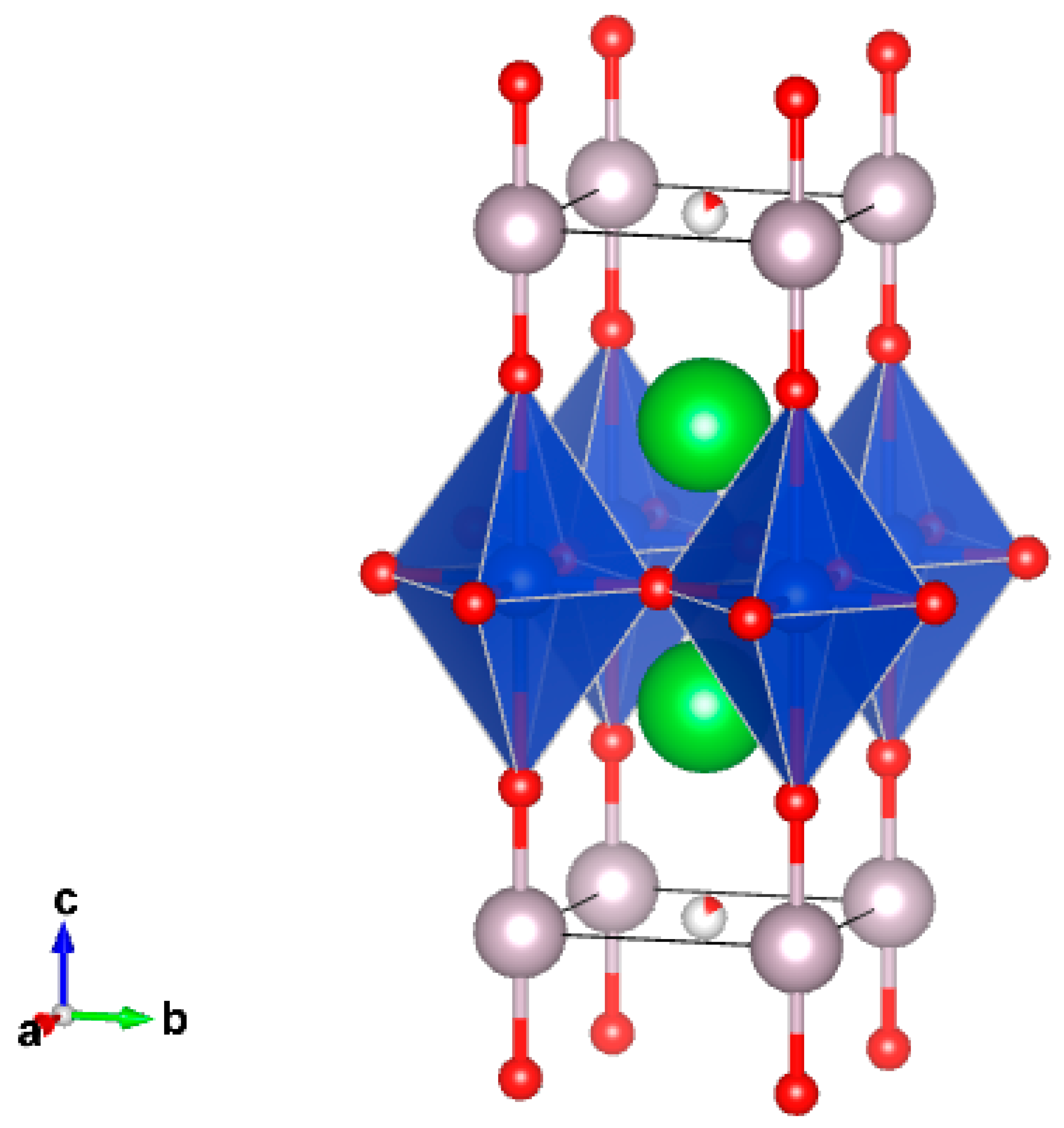
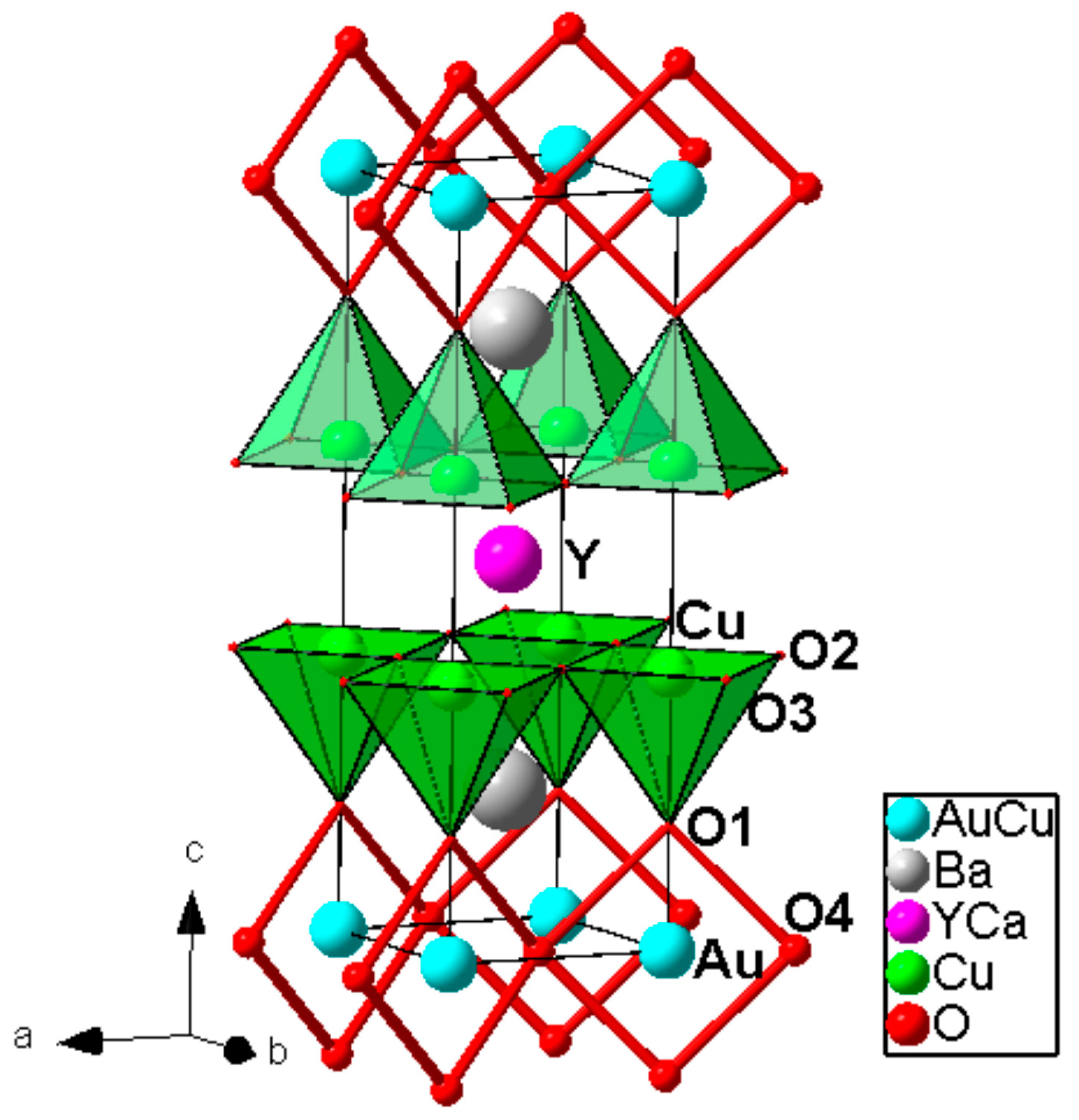
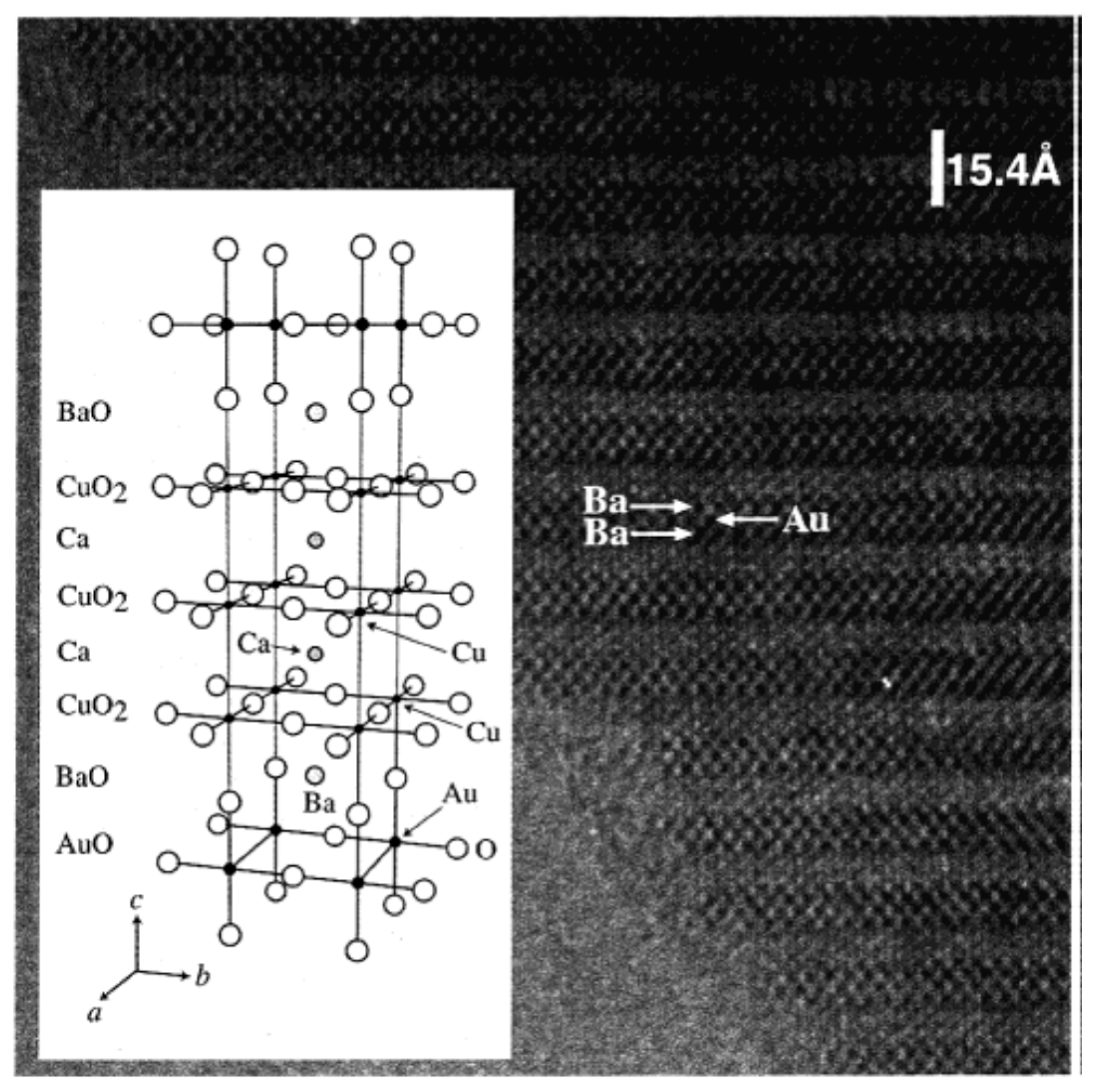
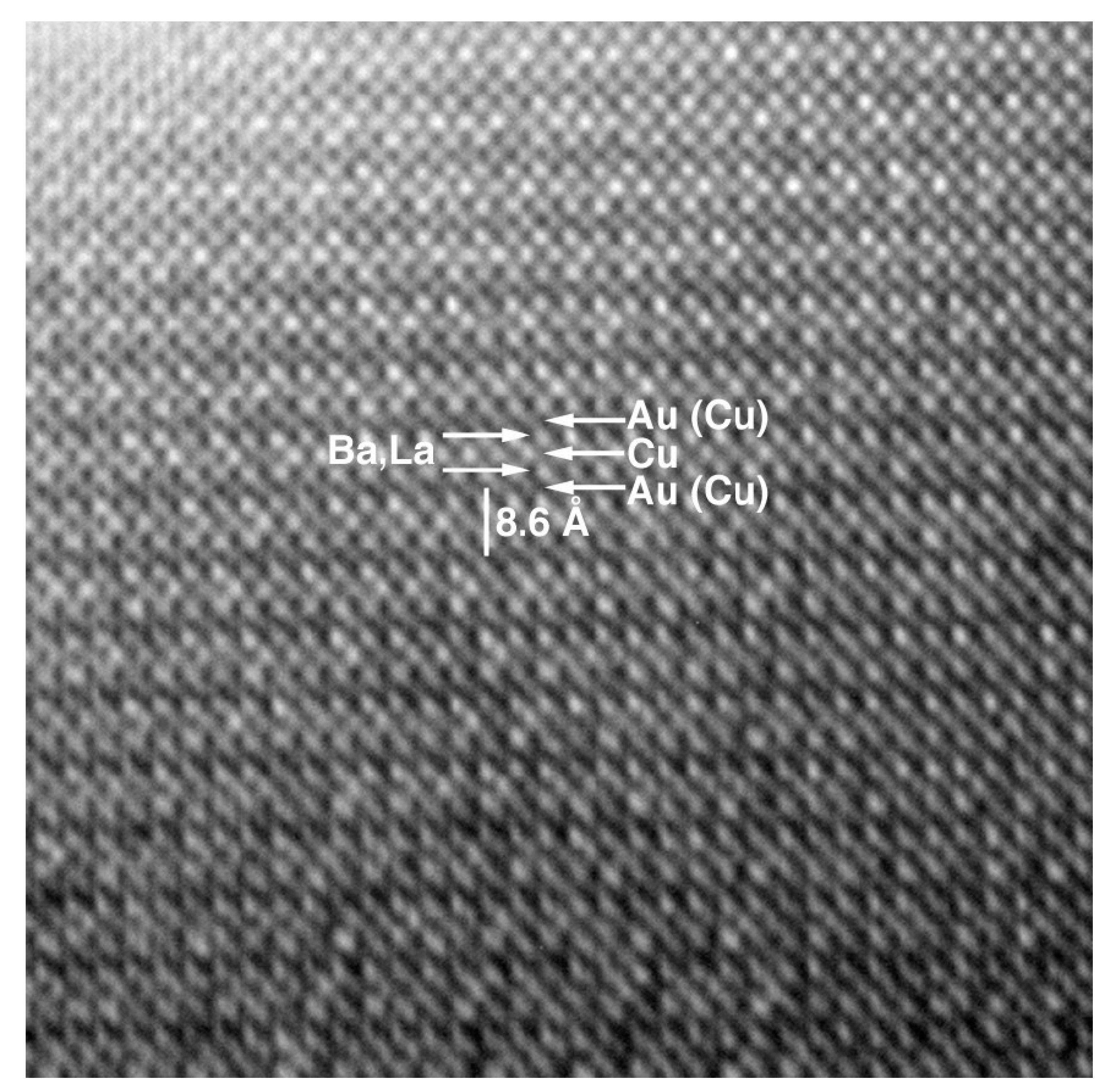
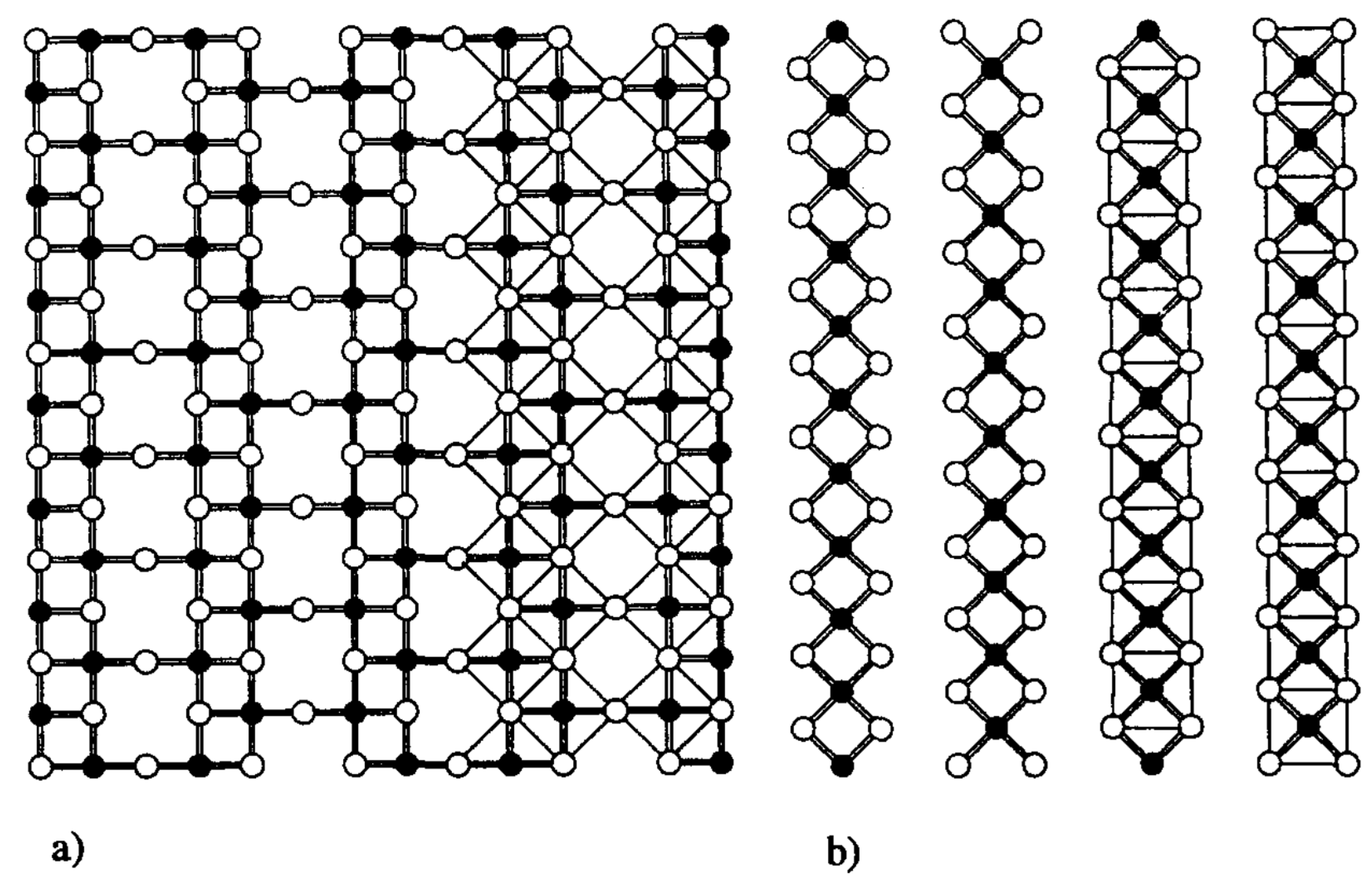
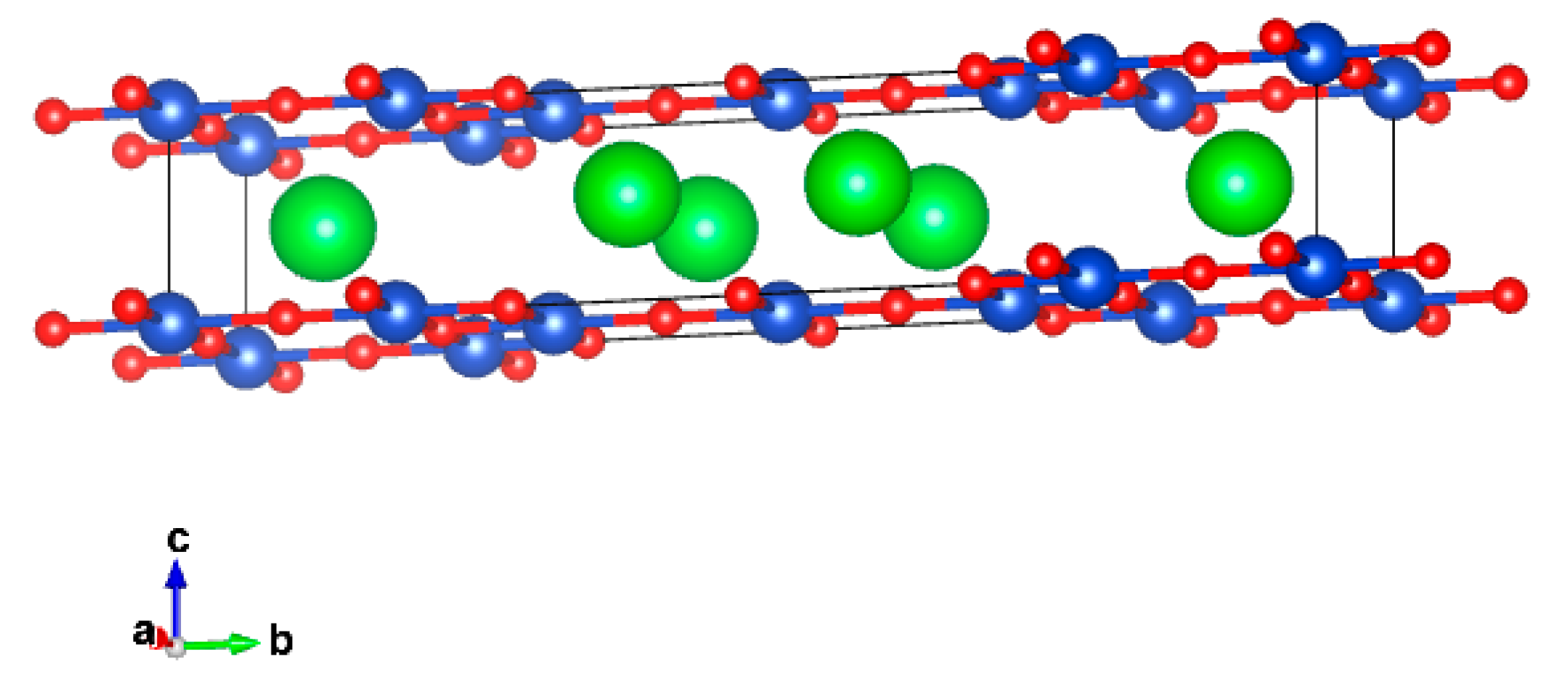
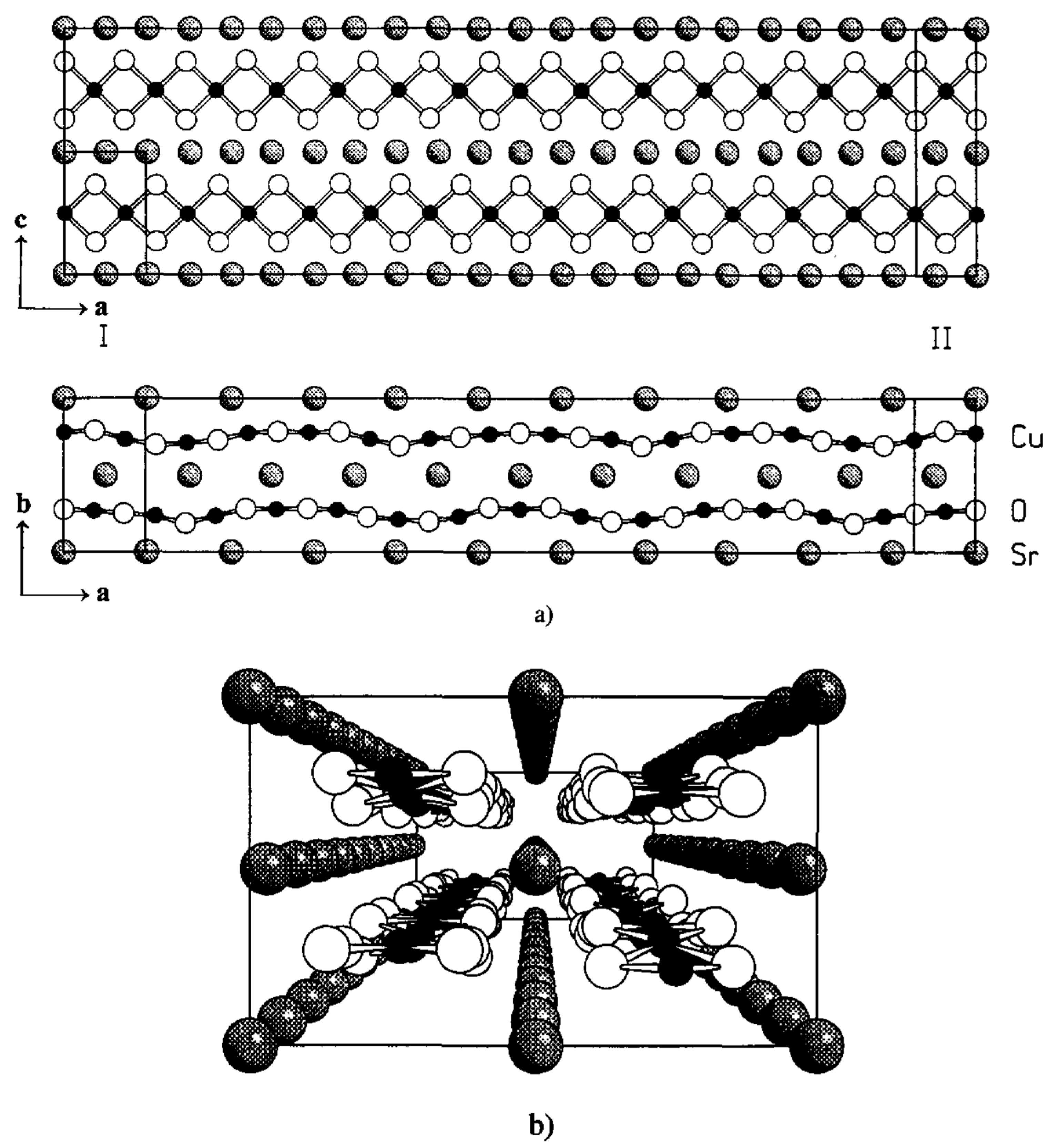
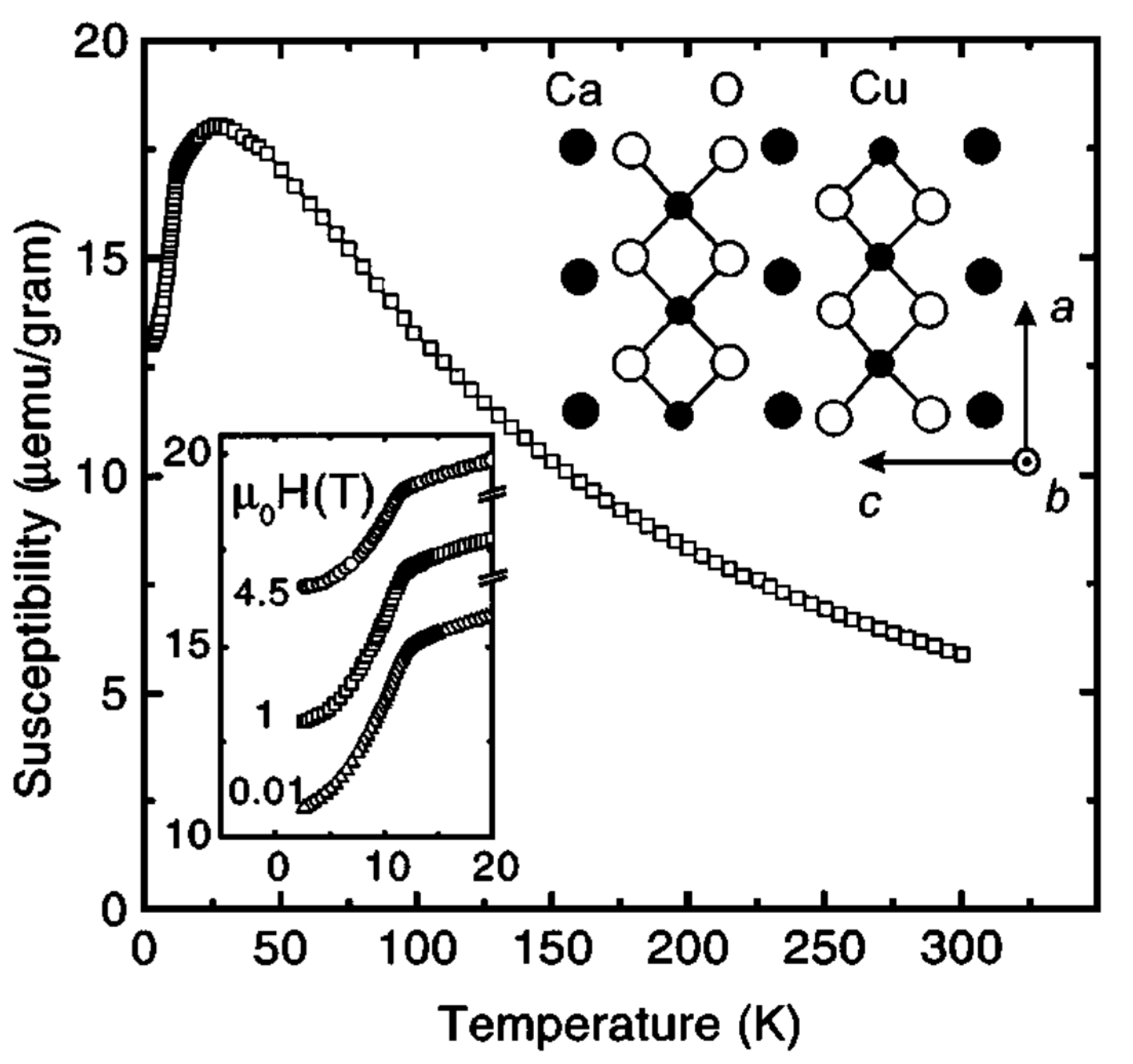
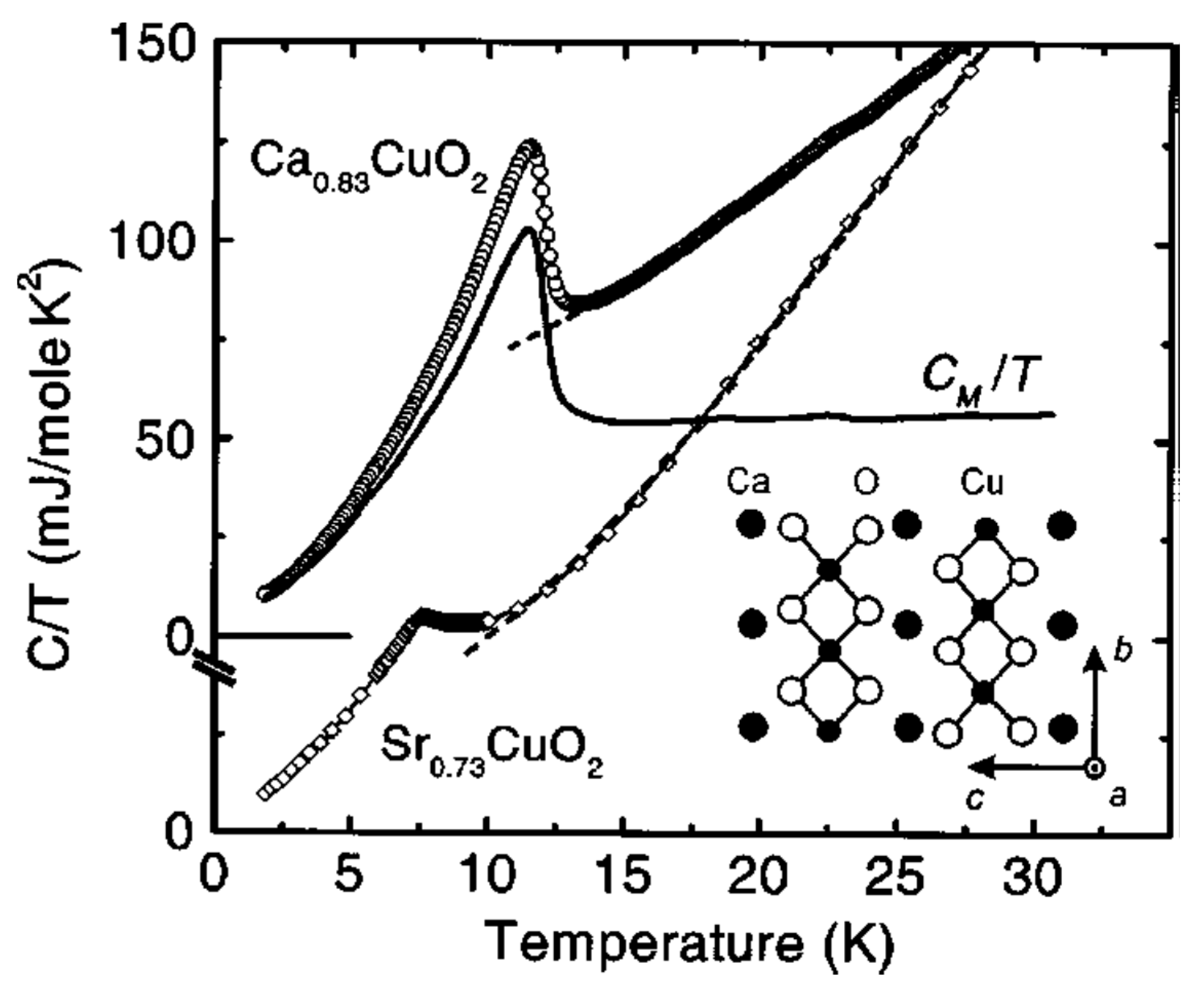

| General Formula | HP for Synthesis | Superconductivity |
|---|---|---|
| I.HgBa2Can−1CunO2n+2+δ (n = 1–6) | HP is required for n = 4–6. | Tc max = 138 K (n = 3), up to 166 K in situ at > 20 GPa |
| II.AuBa2(Ca,Ln)n−1CunO2n+3 (n = 1–4, Ln = rare-earth cations) | HP is required | Tc max = 99 K (n = 4) |
| III.(La,M)n+1CunO2n+2±δ (RP- related): | ||
| 1.(La,M)n+1CunO2n+2+δ (M = Ca, Sr, Ba) | HP isn’t always required for n = 1, 2 | Tc max = 38 K (n = 1), up to 52.5 K in situ at 1.68 GPa. |
| Tc max ~ 100 K for n = 2 (as minor phase) | ||
| 2. Sr2-xBaxCuO3+ô | HP with internal oxidizer is required | Tc max = 98 K at x = 0.6 (bulk ?) |
| 3. Ba2CuO4−y | 18 GPa with internal oxidizer is required | Tc max > 70 K at y = 0.8 (bulk), possibly original mechanism |
| IV.(Cu,A)(Sr,M)2(M,Ln)n−1CunOy (A = B, C, N; M= Ca, Sr, Ba; Ln = rare-earth cations; n = 1–6) | HP is required at least for n = 3–6 members | Tc max = 113 K for (Cu,N,C)Sr2Can−1CunOy (n = 4) |
| V. Srn−1Cun+1O2n (n = 3,5) | HP is required | Not superconducting |
Publisher’s Note: MDPI stays neutral with regard to jurisdictional claims in published maps and institutional affiliations. |
© 2021 by the author. Licensee MDPI, Basel, Switzerland. This article is an open access article distributed under the terms and conditions of the Creative Commons Attribution (CC BY) license (http://creativecommons.org/licenses/by/4.0/).
Share and Cite
Kopnin, E.M. Layered Cuprates Containing Flat Fragments: High-Pressure Synthesis, Crystal Structures and Superconducting Properties. Molecules 2021, 26, 1862. https://doi.org/10.3390/molecules26071862
Kopnin EM. Layered Cuprates Containing Flat Fragments: High-Pressure Synthesis, Crystal Structures and Superconducting Properties. Molecules. 2021; 26(7):1862. https://doi.org/10.3390/molecules26071862
Chicago/Turabian StyleKopnin, Evgeny M. 2021. "Layered Cuprates Containing Flat Fragments: High-Pressure Synthesis, Crystal Structures and Superconducting Properties" Molecules 26, no. 7: 1862. https://doi.org/10.3390/molecules26071862
APA StyleKopnin, E. M. (2021). Layered Cuprates Containing Flat Fragments: High-Pressure Synthesis, Crystal Structures and Superconducting Properties. Molecules, 26(7), 1862. https://doi.org/10.3390/molecules26071862





